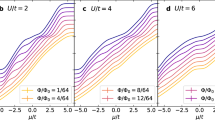Abstract.
The ground state of an electron gas is characterized by the interparticle spacing to the effective Bohr radius ratio r s = a/a B *. For polarized electrons on a two dimensional square lattice with Coulomb repulsion, we study the threshold value r s * below which the lattice spacing s becomes a relevant scale and r s ceases to be the scaling parameter. For systems of small ratios s/a B *, s becomes only relevant at small r s (large densities) where one has a quantum fluid with a deformed Fermi surface. For systems of large s/a B *, s plays also a role at large r s (small densities) where one has a Wigner solid, the lattice limiting its harmonic vibrations. The thermodynamic limit of physical systems of different a B * is qualitatively discussed, before quantitatively studying the lattice effects occurring at large r s . Using a few particle system, we compare exact numerical results obtained with a lattice and analytical perturbative expansions obtained in the continuum limit. Three criteria giving similar values for the lattice threshold r s * are proposed. The first one is a delocalization criterion in the Fock basis of lattice site orbitals. The second one uses the persistent current which can depend on the interaction in a lattice, while it becomes independent of the interaction in the continuum limit. The third one takes into account the limit imposed by the lattice to the harmonic vibrations of the electron solid.
Similar content being viewed by others
References
M. Gell-Mann, K.A. Brueckner, Phys. Rev. 106, 364 (1957)
E. Wigner, Trans. Faraday Soc. 34, 678 (1938)
G. Meissner, H. Namaizawa, M. Voss, Phys. Rev. B 13, 1370 (1976)
W.J. Carr, Phys. Rev. 122, 1437 (1961)
L. Bonsall, A.A. Maradudin, Phys. Rev. B 15, 1959 (1977)
D.M. Ceperley, Phys. Rev. B 18, 3126 (1978)
B. Tanatar, D.M. Ceperley, Phys. Rev. B 39, 5005 (1989)
J. González, Phys. Rev. B 63, 024502 (2000)
J. González, F. Guinea, M.A.H. Vozmediano, Europhys. Lett. 34, 711 (1996)
D. Zanchi, H.J. Schulz, Phys. Rev. B 54, 9509 (1996)
D. Weinmann, J.-L. Pichard, Y. Imry, J. Phys. I France 7, 1559 (1997)
G. Katomeris, F. Selva, J.-L. Pichard, Eur. Phys. J. B 31, 401 (2003)
Z.Á. Németh, J.-L. Pichard, Eur. Phys. J. B 33, 8799 (2003)
M. Martí nez, J.-L. Pichard, Eur. Phys. J. B 30, 93 (2002)
F. Selva, D. Weinmann, Eur. Phys. J. B 18, 137 (2000)
J. Ruvalds, C.T. Rieck, S. Tewari J. Thoma, A. Virosztek, Phys. Rev. B 51, 3797 (1995)
G.G. Amatucci, J.M. Tarascon, L.C. Klein, J. Electrochem. Soc. 143, 1114 (1996); K. Takada et al. , Nature 422, 53 (2003)
M. Roger, N. Shannon, unpublished
P.W. Anderson, Phys. Rev. 109, 1492 (1958)
D. Weinmann, J.-L. Pichard, Phys. Rev. Lett. 77, 1556 (1996)
D.L. Shepelyansky, O.P. Sushkov, Europhys. Lett. 37, 121 (1997)
G. Benenti, G. Casati, D.L. Shepelyansky, Eur. Phys. J. D 17, 265 (2001)
B.L. Altshuler, Y. Gefen, A. Kamenev, L. Levitov, Phys. Rev. Lett. 78, 2803 (1997)
P. Jacquod, D.L. Shepelyansky, Phys. Rev. Lett. 79, 1837 (1997)
A. Müller-Groeling, H.A. Weidenmüller, Phys. Rev. B 49, 4752 (1994)
I.V. Krive, P. Sandström, R.I. Shekhter, S.M. Girvin, M. Jonson, Phys. Rev. B 52, 16451 (1995)
G. Burmeister, K. Maschke, Phys. Rev. B 65, 155333 (2002)
Author information
Authors and Affiliations
Corresponding author
Additional information
Received: 20 January 2004, Published online: 18 June 2004
PACS:
71.10.-w Theories and models of many-electron systems - 71.10.Fd Lattice fermion models (Hubbard model, etc.) - 73.20.Qt Electron solids
Rights and permissions
About this article
Cite this article
Falakshahi, H., Németh, Z.Á. & Pichard, JL. Effect of a lattice upon an interacting system of electrons in two dimensions: Breakdown of scaling and decay of persistent currents. Eur. Phys. J. B 39, 93–105 (2004). https://doi.org/10.1140/epjb/e2004-00175-0
Issue Date:
DOI: https://doi.org/10.1140/epjb/e2004-00175-0




